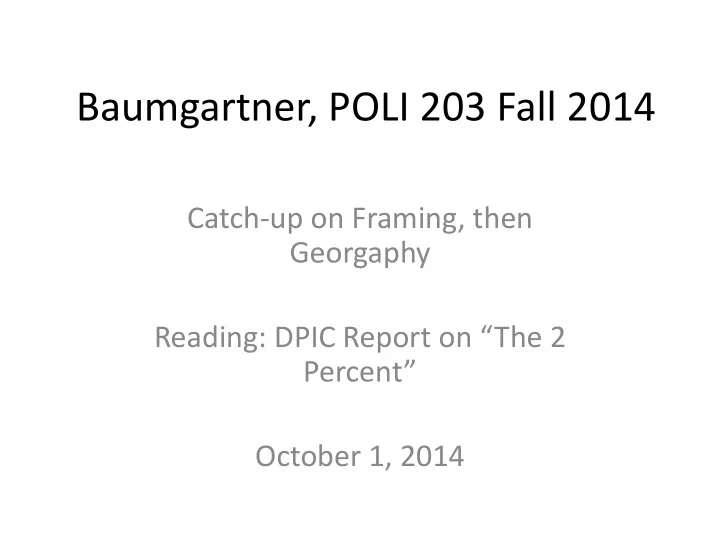

Baumgartner, POLI 203 Fall 2014 Catch-up on Framing, then Georgaphy Reading: DPIC Report on “The 2 Percent” October 1, 2014
Catching up • Speaker tonight: Ballard Everett • https://www.facebook.com/NCCCADP • http://conservativesconcerned.org/ • Come with questions, he may not lecture the entire time but wants to have a discussion.
Catching up • NYT v. other newspapers / media outlets – See last slides from Monday’s lecture, which I did not get to. • From victim to inmate – See following slides, from the same project – Big surprise, interesting finding, a shift from attention to the victim to the defendant over time.
Mentions of Victim and Defendant
Any mention of victim has the same effect
Any mention of the defendant, except one, has same effect
Story mentions victim? 64/36 pro. Story mentions inmate? 27 / 73 pro.
Net Attention to Victim compared to Inmate
This is reinforced by the innocence frame, shifts attention • General point: all cases have a victim and a defendant. • Similarly, all public policies have multiple aspects or dimensions of consideration • Surprisingly, as a society, we collectively shift our attention from one to another over time. • Rarely do we maintain a comprehensive balance. • Policies then follow these changes in attention or focus.
Compare Victim-Focus to Tone
The 2 Percent Report • Harris is #1 on executions, #2 on sentences • Other high sentencing counties not represented in the high executions list – LA, Phila, Oakland, Phoenix, New Orleans
A Pareto-Distribution • Across geographic units, executions are distributed as Pareto noted that wealth is distributed: A small number of the units have a large percentage of the executions. • Pareto suggested a model by which the “rich get richer” – a proportionate growth model. • Why do some jurisdictions never or rarely impose the death penalty while others do so more by several orders of magnitude?
Proportionate Growth with a Random Start • Assume a random start, and different units begin with different sizes (or histories) • Subsequent growth is proportionate to size. – Think: web sites with more prominence continue to get more links to them, increasing their prominence – Big companies may grow faster than smaller ones, leveraging their advantages in scale – The rich get richer How might this apply to the development of a “local legal culture”?
Six actors in the US system • Prosecutor • Defense (Public Defender’s Office, funded by state) • Juries • Judges • State appellate courts • US circuit courts • (US Supreme court as well, but affects all actors equally)
Assume no executions so far in your jurisdiction • Next heinous murder occurs • Probably not the most heinous in local history – Therefore does not merit more severe punishment • Prosecutor has no confidence that: – He has the staff experience to do it – Defense attorneys cannot fight successfully – Juries will go for it – Judges will allow it – Appellate courts will sanction it
Assume some previous executions • Next heinous murder occurs • It may well be more heinous than some previous case which led to execution • Prosecutor has confidence that: – He has the staff experience to do it (and maybe a younger lawyer who needs a promotion) – Juries will go for it – Public Defender is under-funded and ill-equipped – Judges will allow it (and keep the Defender weak) – Appellate courts will sanction it
Local norms developing independently • Baseline factors: – Former slave states – High minority population • But why Houston and not, say, New Orleans? • Random start, then self-reinforcement • If we can show this it excludes “equal justice” as a factor, which could be unconstitutional
Empirical Expectations • Time elapsed between executions then decline with each successful case • Executions per year should be predicted by number of previous executions, more than by number of murders or the crime rate • Patterns should not be predictable based on simple geography or slave-state status • Should hold at all levels of scale • Pattern should move from relatively random (murders) to relatively extreme as we move through the stages of the process: capital charges brought, sentences, executions • Outliers should always be present but may not always be the same in different historical periods
Five levels of scale, same pattern • ~3,000 counties in the US • Counties within individual states • The 50 states • The 12 federal judicial circuits • ~200 countries of the world • Patterns are not identical and some are more exponential than Paretian, but all are extreme
Percent Minority Population
These trends also hold for individual states • The following slides show similar analyses for the state with by far the greatest number of executions, Texas, and for North Carolina. • We can have greater confidence in the national analysis since it is based on a larger number of observations, but the pattern also holds within individual states.
Are the stages progressively more skewed? • For North Carolina, I have data from the state indigent defense services database of all murder cases from approx 1977 to 2011. • Following slides show progressively more skew in the distributions as we move from: • Murders • Death sentences • Executions
Murders are not close to a log-log distribution but executions are
Murders, Sentences, and Executions are imperfectly correlated
Note: this shows murders and executions, not death sentences
Recommend
More recommend